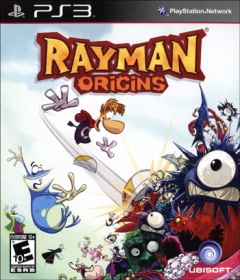Rayman Origins
| Rayman Origins | |
|---|---|
 |
|
| Platforms | PlayStation 3, Xbox 360, Wii, PlayStation Vita, Nintendo 3DS |
| Genre | Slap-happy platformer |
| MtAMinutes to Action | 1 |
| Keep Playing? | Yes |
| Buy from Amazon | |
I had never played a Rayman game before last year, when I tried Rayman 3D. A port of the most renowned Rayman game, it didn't exactly endear the limbless whatsit to me. So when Rayman Origins was released six months ago, I was too busy scampering through Super Mario 3D Land to care.
Thus, I was busy gazing into a 3D mushroom kingdom when Origins earned rave reviews. The acclaim seemed fruitless, as Rayman Origins found slow initial sales and an early price slash. Still, the game made enough cash that a sequel is (almost certainly) on the way.
I had intended to check out Rayman Origins since it was showered with critical adulation, but it was the sequel leak (and heavy discounting) that pushed me into finally buying the game. I'm pretty keen at picking apart platformers in just a few minutes of play, so my first impressions of the game all but cemented my new outlook on Rayman.
- The opening cutscene shows off a lot of what I like about the game's audiovisual design. Gorgeous hand-drawn sprites and thoughtful sound arrangement come together to make a classic cartoon sequence. In a lot of ways, the presentation reminds me of an offbeat Nickelodeon cartoon, wacky and slightly unsettling but in a cheerful tone. The music and sound effects are integrated into the actual game as well, with subtle recurring themes and dynamic changes accompanying every situation.
- I'm stubborn in my preferences for platformer controls, so it's not a big surprise that Rayman Origins didn't perfectly "click" for me right away. The game uses the Super Mario Bros standard of a run button and a jump button for movement, but I'm still feeling out the nitty gritty of how momentum and resistance and whatnot affect movement. Rayman's automatic functions, like grabbing ledges and sliding down walls, are looser and a bit more ambiguous than I'd like, while his controllable movements are a bit stiffer than I prefer. While it doesn't quite feel perfect to me, the controls certainly up to the task and haven't come close to frustrating me yet. Can't say I'm a fan of the slaps, punches, and whirlwind attacks that are required to beat some enemies, though, I think they only break the flow of the otherwise smooth platforming.
- The linear level design is nothing new in modern pure platformers, but the ground layout is very curvy and smooth, compared to the more rigid, angular style of Nintendo platformers. It makes for a unique look, but it also makes some collision points unclear. It hasn't proven problematic thus far, though, and I don't see it being a problem going forward.
- The primary objective in each stage is to free the captive pink...things at the end of the level, but the game also tracks how many Lums the player collects in each stage, unlocking extra stages with more of the collectables. Some are hidden just off-screen or behind foreground elements, pretty standard fare for any platformer with doodads to find.
- At the end of the first world, I hopped onto a giant mosquito and was taken through a sidescrolling shmup level. I guess shooting up enemies Gradius style was meant to add variety, but I found it rather dull. It's no crime, though.
Minutes to Action: 1
Would I Keep Playing? Yes. I can find plenty of trivial things to complain about, but that's true for many of my favorite games as well. The strong audiovisual design and solid gameplay in the first hour have me interested in seeing just how creative the challenges become in the later parts of the game.
